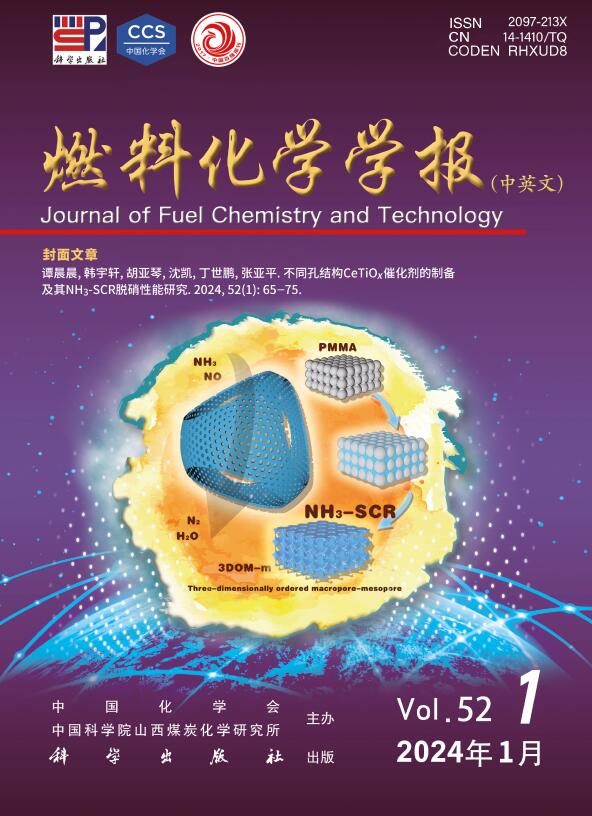构建石墨- ceo2界面增强太阳能驱动甲烷干重整的光热活性
Q3 Energy
引用次数: 0
摘要
CeO2基半导体广泛应用于太阳能光热催化甲烷干重整(DRM)反应中,但存在活性低、光利用率低的问题。本研究开发了石墨- ceo2界面,以增强太阳能驱动的光热催化DRM。与碳纳米管修饰的CeO2 (CeO2- cnt)相比,石墨修饰的CeO2 (CeO2- gra)在CeO2中形成了扭曲的石墨-CeO2界面,从而形成了丰富的氧空位。这些具有氧空位的石墨- ceo2界面增强了光吸收,促进了光生载流子的生成和分离。石墨的高吸热容量使催化剂表面温度从592.1℃提高到691.3℃,促进了光热转化。光生载流子与局域热的协同作用使Ni/CeO2- gra的CO产率达到9985.6 mmol/(g·h) (Ni/CeO2为7192.4 mmol/(g·h)),光燃料效率为21.8% (Ni/CeO2为13.8%)。这项工作为设计石墨-半导体界面以提高光热催化效率提供了见解。本文章由计算机程序翻译,如有差异,请以英文原文为准。
Constructing graphite-CeO2 interfaces to enhance the photothermal activity for solar-driven dry reforming of methane
CeO2 based semiconductor are widely used in solar-driven photothermal catalytic dry reforming of methane (DRM) reaction, but still suffer from low activity and low light utilization efficiency. This study developed graphite-CeO2 interfaces to enhance solar-driven photothermal catalytic DRM. Compared with carbon nanotubes-modified CeO2 (CeO2-CNT), graphite-modified CeO2 (CeO2-GRA) constructed graphite-CeO2 interfaces with distortion in CeO2, leading to the formation abundant oxygen vacancies. These graphite-CeO2 interfaces with oxygen vacancies enhanced optical absorption and promoted the generation and separation of photogenerated carriers. The high endothermic capacity of graphite elevated the catalyst surface temperature from 592.1−691.3 ℃, boosting light-to-thermal conversion. The synergy between photogenerated carriers and localized heat enabled Ni/CeO2-GRA to achieve a CO production rate of 9985.6 mmol/(g·h) (vs7192.4 mmol/(g·h) for Ni/ CeO2) and a light-to-fuel efficiency of 21.8% (vs13.8% for Ni/ CeO2). This work provides insights for designing graphite-semiconductor interfaces to advance photothermal catalytic efficiency.
求助全文
通过发布文献求助,成功后即可免费获取论文全文。
去求助
来源期刊

燃料化学学报
Chemical Engineering-Chemical Engineering (all)
CiteScore
2.80
自引率
0.00%
发文量
5825
期刊介绍:
Journal of Fuel Chemistry and Technology (Ranliao Huaxue Xuebao) is a Chinese Academy of Sciences(CAS) journal started in 1956, sponsored by the Chinese Chemical Society and the Institute of Coal Chemistry, Chinese Academy of Sciences(CAS). The journal is published bimonthly by Science Press in China and widely distributed in about 20 countries. Journal of Fuel Chemistry and Technology publishes reports of both basic and applied research in the chemistry and chemical engineering of many energy sources, including that involved in the nature, processing and utilization of coal, petroleum, oil shale, natural gas, biomass and synfuels, as well as related subjects of increasing interest such as C1 chemistry, pollutions control and new catalytic materials. Types of publications include original research articles, short communications, research notes and reviews. Both domestic and international contributors are welcome. Manuscripts written in Chinese or English will be accepted. Additional English titles, abstracts and key words should be included in Chinese manuscripts. All manuscripts are subject to critical review by the editorial committee, which is composed of about 10 foreign and 50 Chinese experts in fuel science. Journal of Fuel Chemistry and Technology has been a source of primary research work in fuel chemistry as a Chinese core scientific periodical.
 求助内容:
求助内容: 应助结果提醒方式:
应助结果提醒方式:


